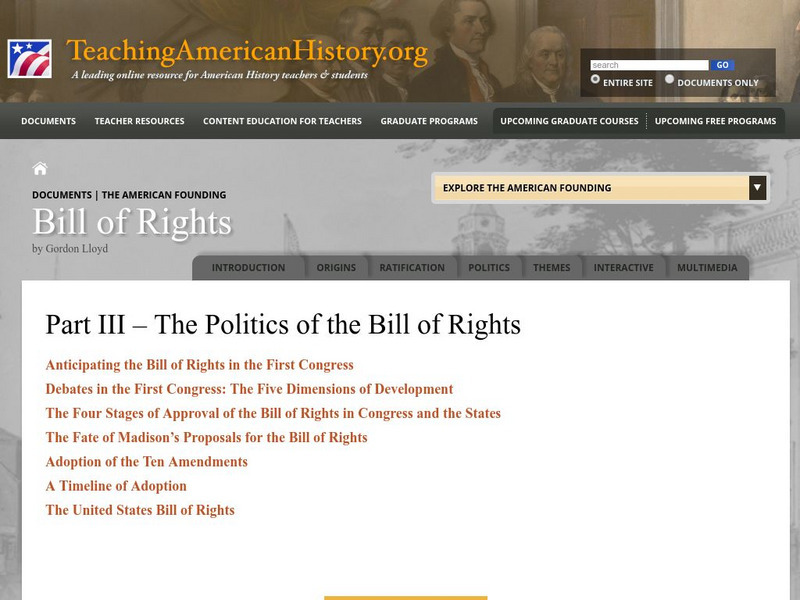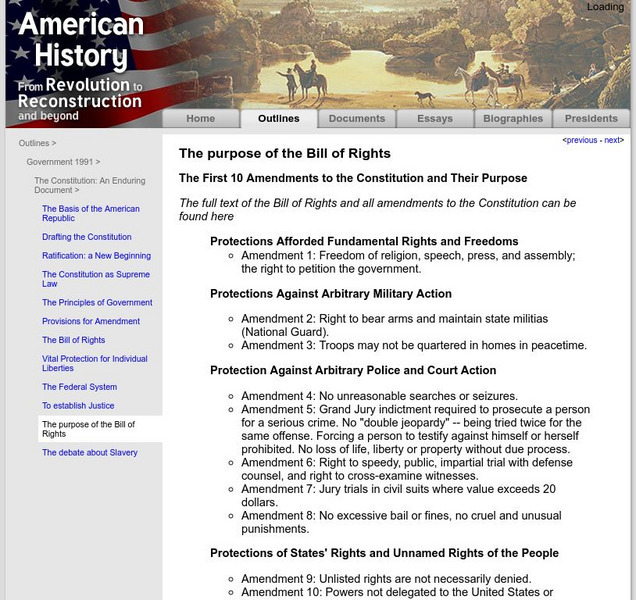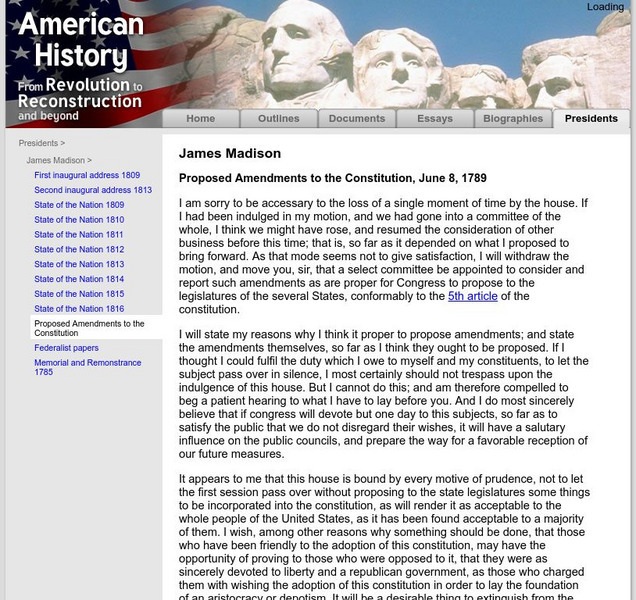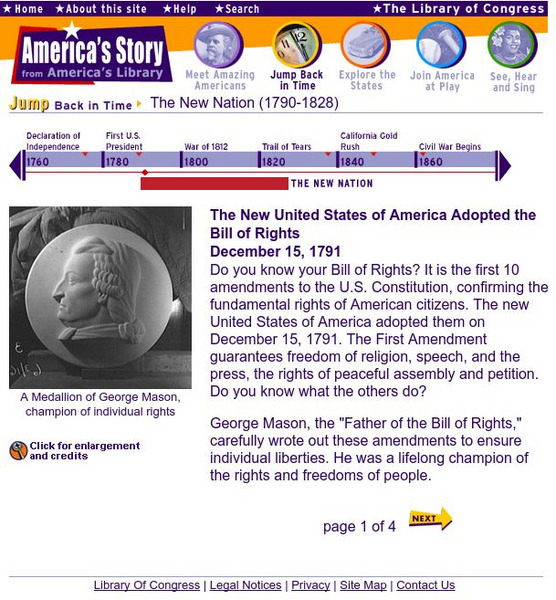Teaching American History
Teaching American History: The Politics of the Bill of Rights: Part Iii
Investigate what the politics were leading to the creation of the Bill of Rights. Identify how the debates in the first congress led to the stages of approval and ultimately the adoption of the ten amendments to the U.S. Constitution.
US National Archives
National Archives: Congress Creates the Bill of Rights
A set of activities that link to a mobile app called "Congress Creates the Bill of Rights." The materials used in the app can also be downloaded in PDF format. There is also a free ebook in epub format that is incorporated into the...
Bill of Rights Institute
Bill of Rights Institute: Supreme Court Gps Warrant Hearing
Investigators must acquire a search warrant before intitiating a GPS search of a vehicle to track criminals, decided upon by justices, so as not to infringe on the rights of search and seizure stated in the Bill of Rights. This lesson...
Bill of Rights Institute
Bill of Rights Institute: Property Rights and the Supreme Court
A question over a piece of property owned by one, yet deemed protected by the EPA prompted a court case in search of due process and protection of property rights. Find out more about the case and the process through this lesson plan.
University of Groningen
American History: Outlines: The Purpose of the Bill of Rights
Text of the first ten amendments of the Constitution found in the Bill of Rights.
iCivics
I Civics: No Bill of Rights, No Deal
In the debate over the Constitution, the Bill of Rights was a deal-breaker. In this lesson, learners learn why the federalists thought the Constitution didn't need a bill of rights and why the anti-federalists refused to accept the...
Scholastic
Scholastic: Explaining the Bill of Rights
Read about the need for a Bill of Rights to be added to the Constitution. Find out what each of the first ten amendments means.
National Endowment for the Humanities
Neh: Edsit Ement: The Creation of the Bill of Rights: "Retouching the Canvas"
In this lesson plan, students will consider "The Creation of the Bill of Rights: "Retouching the Canvas"." The plan includes worksheets and other student materials that can be found under the resource tab.
Incredible Art Department
The Incredible Art Department: Constitution Day
Discusses the origin of Constitution Day and the history of the Constitution and the Bill of Rights. Lists descriptions of the seven articles and twenty-seven amendments in the Constitution. Presents lesson suggestions from teachers and...
Bill of Rights Institute
Bill of Rights Institute: Voters Make History With State Ballot Initiatives
Eminent Domain, Gay Marriage, Abortion, Marijuana, and the Death Penalty are a few issues that were on some state ballots in recent years. This lesson addresses the relationship these initiatives have with our constitutional rights.
Bill of Rights Institute
Bill of Rights Institute: Airport Scanners and the Fourth Amendment
Allow students opportunity to evaluate the constitutionality of the TSA full body airport scanners with this lesson plan.
Bill of Rights Institute
Bill of Rights Institute: The Stolen Valor Act and False Speech
A lesson plan, including an extension opportunity, addressing whether the Stolen Valor Act violates the First Amendment to the U.S. Constitution.
Bill of Rights Institute
Bill of Rights Institute: Gouverneur Morris
A lesson plan introducing or revisiting the role of Gouverneur Morris in the planning and writing of the United States Constitution.
Bill of Rights Institute
Bill of Rights Institute: Religious Freedom and the Affordable Healthcare Act
Summary, resources, and activities addressing the constitutionality with regard to the first amendment which surfaced with the Affordable Healthcare Act.
iCivics
I Civics: You've Got Rights!
Students learn about the rights guaranteed by the Bill of Rights and other important constitutional amendments.
Digital History
Digital History: A Bill of Rights? [Pdf]
There was no Bill of Rights attached to the original Constitution, but it was a topic of discussion. Read a reconstruction of speeches of delegates to the Constitutional Convention who debated for and against the inclusion of a way to...
Alabama Learning Exchange
Alex: Circling the Bill of Rights
This is a hands-on, inquiry project to create a 3-D graphic organizer for the research and study of the Bill of Rights. It may be a stand-alone activity or may be included as part of a unit of study on the Constitution. Students will...
University of Groningen
American History: Presidents: James Madison: Proposed Amendments to Constitution
Text of James Madison's "Proposed Amendments to the Constitution," June 8, 1789. Madison states his reasons for the amendments in view of the anti-federalist feelings in many of the colonies. The proposal explains in Madison's own words...
Annenberg Foundation
Annenberg Classroom: That's Your Right
An engaging online card game where students learn about the Bill of Rights by matching situations with the correct right. There are three levels of difficulty. Includes a short video for each of the first ten Amendments to the...
Other
Brigham Young University: Constitution: The Game
A game where the player must sort items into whether they belong in the body of the Constitution, the Bill of Rights, the Amendments, the Articles, or not at all. There are two rounds to the game.
Library of Congress
Loc: The Bill of Rights: Debating the Amendments
Help students grasp the idea of making amendments with this instructional activity on the debates of the amendments to the US Constitution. Use primary sources to have the students choose their own amendments, give them opportunity to...
Library of Congress
Loc: America's Story: Bill of Rights
The Bill of Rights was adopted to protect each United States citizen's rights. Learn about how the Bill of Rights was formed and the protections it guarantees to Americans.
Bill of Rights Institute
Bill of Rights Institute: Additional Amendments
The Constitution contains within itself the process of changing it. The amendment process is described in Article 5. Amendments can be proposed in Congress when 2/3rd of both Houses agree. The states can play a role in proposing changes...
Bill of Rights Institute
Bill of Rights Institute: James Madison
James Madison's slight stature and reserved personality gave little indication of his keen intellect and shrewd nature. No other Founder had as much influence in crafting, ratifying, and interpreting the United States Constitution and...













